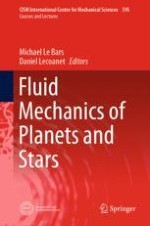2020 | OriginalPaper | Chapter
5. Fluid Dynamics of Earth’s Core: Geodynamo, Inner Core Dynamics, Core Formation
Authors : Renaud Deguen, Marine Lasbleis
Published in: Fluid Mechanics of Planets and Stars
Publisher: Springer International Publishing
Activate our intelligent search to find suitable subject content or patents.
Select sections of text to find matching patents with Artificial Intelligence. powered by
Select sections of text to find additional relevant content using AI-assisted search. powered by
